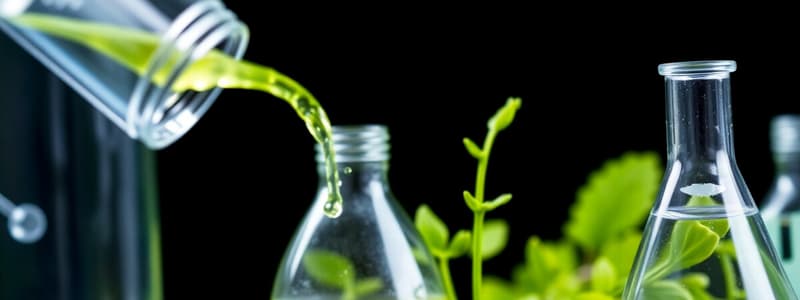Podcast
Questions and Answers
Which technique is essential for observing cells and other microscopic structures?
Which technique is essential for observing cells and other microscopic structures?
- Computational Biology
- Microscopy (correct)
- Biochemistry
- Immunology
What area of current research focuses on the interactions between different parts of biological systems?
What area of current research focuses on the interactions between different parts of biological systems?
- Cancer research
- Systems biology (correct)
- Genetics
- Synthetic biology
Which of the following techniques provides insights into genetic processes?
Which of the following techniques provides insights into genetic processes?
- Molecular Biology techniques (correct)
- Biochemistry
- Experimental design and analysis
- Immunology
What current research area is concerned with improving crop yields and food production?
What current research area is concerned with improving crop yields and food production?
Which area investigates the immune system's role in fighting diseases?
Which area investigates the immune system's role in fighting diseases?
What is the primary focus of life sciences?
What is the primary focus of life sciences?
Which branch of life sciences specifically studies microorganisms?
Which branch of life sciences specifically studies microorganisms?
What fundamental principle is established by cell theory?
What fundamental principle is established by cell theory?
How does homeostasis benefit living organisms?
How does homeostasis benefit living organisms?
Which of the following is NOT a key concept in life sciences?
Which of the following is NOT a key concept in life sciences?
What does the field of molecular biology primarily investigate?
What does the field of molecular biology primarily investigate?
Why are life sciences important for addressing global challenges?
Why are life sciences important for addressing global challenges?
What is the process through which organisms adapt to their environments called?
What is the process through which organisms adapt to their environments called?
Flashcards
Life Sciences
Life Sciences
Study of all living organisms, from microbes to mammals, encompassing biology, chemistry, and physics.
Biology
Biology
Study of life in all its forms, encompassing various subcategories like genetics, microbiology, ecology, zoology and botany.
Genetics
Genetics
Study of genes and heredity, how traits are passed down.
Microbiology
Microbiology
Signup and view all the flashcards
Ecology
Ecology
Signup and view all the flashcards
Cell Theory
Cell Theory
Signup and view all the flashcards
Evolution
Evolution
Signup and view all the flashcards
Homeostasis
Homeostasis
Signup and view all the flashcards
Metabolism
Metabolism
Signup and view all the flashcards
Molecular Biology
Molecular Biology
Signup and view all the flashcards
Adaptation
Adaptation
Signup and view all the flashcards
Microscopy
Microscopy
Signup and view all the flashcards
Biochemistry
Biochemistry
Signup and view all the flashcards
Molecular Biology
Molecular Biology
Signup and view all the flashcards
Computational Biology
Computational Biology
Signup and view all the flashcards
Immunology
Immunology
Signup and view all the flashcards
Experimental design
Experimental design
Signup and view all the flashcards
Systems Biology
Systems Biology
Signup and view all the flashcards
Synthetic Biology
Synthetic Biology
Signup and view all the flashcards
Cancer Research
Cancer Research
Signup and view all the flashcards
Genetics/Genomics
Genetics/Genomics
Signup and view all the flashcards
Immunotherapy
Immunotherapy
Signup and view all the flashcards
Biodiversity
Biodiversity
Signup and view all the flashcards
Climate change effects
Climate change effects
Signup and view all the flashcards
Agriculture and Food Science
Agriculture and Food Science
Signup and view all the flashcards
Conservation Biology
Conservation Biology
Signup and view all the flashcards
Study Notes
Introduction to Life Sciences
- Life sciences encompass the study of all living organisms, from the smallest microorganisms to the largest mammals.
- The field includes a broad range of disciplines, including biology, chemistry, and physics.
- It focuses on understanding the structure, function, growth, origin, evolution, and distribution of living things.
- It investigates the interactions between organisms and their environment.
Branches of Life Sciences
-
Biology: The study of life in all its forms. This includes many subcategories like:
- Genetics: The study of genes and heredity.
- Microbiology: The study of microorganisms.
- Ecology: The study of the interactions between organisms and their environment.
- Zoology: The study of animals.
- Botany: The study of plants.
-
Chemistry: Essential for understanding the molecular basis of life. This includes:
- The chemical reactions that occur within cells.
- The structure and properties of biological molecules.
- Analyzing chemical compounds in living organisms.
-
Physiology: The study of how living organisms function.
Key Concepts in Life Sciences
- Cell Theory: All living organisms are composed of cells, the basic unit of life.
- Evolution: Organisms have evolved over time through natural selection, adapting to their environments.
- Homeostasis: Organisms maintain a stable internal environment despite changes in their surroundings.
- Metabolism: The sum of all chemical reactions occurring within an organism.
- Genetics: The study of hereditary traits and how they're passed from one generation to the next.
- Adaptation: The process by which organisms become better suited for their environments.
Molecular Biology
- This branch focuses on the molecular processes within cells.
- Key molecules include proteins, nucleic acids (DNA and RNA), carbohydrates, and lipids.
- It investigates how these molecules interact and how their interactions create the essential processes to maintain life.
- Molecular biology heavily relies on experimental methodologies.
Importance of Life Sciences
- Understanding the diversity and evolutionary history of life on Earth.
- Finding solutions to global challenges such as food security, disease, and environmental issues.
- Developing new technologies and treatments for illnesses.
- Promoting conservation efforts to protect endangered species and ecosystems.
- Understanding the intricacies of life to better appreciate and protect our planet and its inhabitants.
Tools and Techniques in Life Sciences
- Microscopy: Essential for observing cells and other microscopic structures.
- Biochemistry: Studying chemical processes within cells.
- Molecular Biology techniques: Cloning, gene expression, etc. provide insights into genetic processes.
- Computational Biology: Utilizing computers to analyze biological data and make predictions.
- Immunology: The study of the immune system and defenses.
- Experimental design and analysis: Essential for drawing conclusions from scientific studies.
Areas of Current Research
- Systems biology: Understanding interactions between different parts of a biological system.
- Synthetic biology: Design and construction of new biological parts, devices, and systems.
- Cancer research: Investigating the causes and developing treatments for cancer.
- Genetics and genomics: Understanding the genetic makeup of organisms and its impact on health and disease.
- Immunotherapy: Utilizing the immune system to battle diseases.
- Climate change effects on biodiversity: Investigating the impact of climate change.
- Agriculture and food science: Improving crop yields and food production.
- Conservation biology: Strategies for protecting biodiversity.
Studying That Suits You
Use AI to generate personalized quizzes and flashcards to suit your learning preferences.



